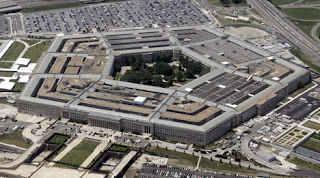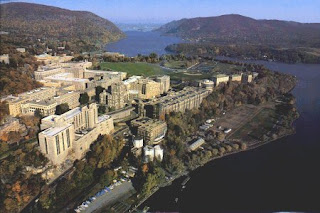The Pentagon, USA
Attention! I, Vany Sampayo, keep myself neutral about what I say. This document was prepared under a lot of research, so that is not said anything false or that compromises the authorities to which I present the most sincere respect.
Information taken from websites and the program "America's Book of Secrets: The Pentagon" by the History Channel and pictures taken from Google Images. Thank you.
 |
| The Pentagon |
It is the epicenter of military operations and power in the USA. A fortress with one single goal: to defend and protect the country. The largest U.S. secrets are there and in certain minds. It is a building, an institution, a fortress and a symbol of military power. Here are incorporated the Department of Defense, the General Staff of the Armed Forces and the five branches of the Armed Forces, Navy, Army, Marines, Air Force and Coast Guard (message Believe! by Vany -- Armed Forces, USA). The orders that come from here coordinate the actions of Americans in the world. The Pentagon is the heart, mind and soul of the military community. Workers call it the Puzzle Palace for being so labyrinthine. The design promotes rapid arrival at any one of its sides. But the Pentagon is much more than that, it is an entity. What most people do not know is that it is like a secret city, it has pharmacies, shops, restaurants, hospitals, athletic center, etc. that serve their 23,000 employees on 24 hour a day, 7 days a week. The truth is that the Pentagon was not to be, in the initial project, a pentagon but with the change of site for construction it ended up being one. But why is the work of construction began on September 11, 1941, three months before the Japanese dropped bombs on Pearl Harbor? Were they secretly preparing for war? The War Department (then so called) was spread across the country and the Pentagon was created to unite and centralize it. The President Roosevelt wanted it to serve, after the war, as a archive place. It was completed in just 16 months. For 70 years it severs its original purpose. It is also a target for terrorism and for all the reasons above.
 |
| September 11, 2001 |
In September 11, 2001, the Al-Qaeda was preparing to attack, with commercial airplanes, points with strategic, political, economic and military importance. One of the planes headed for the Pentagon, flew it and finally crashed in the western part. It was extraordinary to see the employees who had been evacuated get back to help the others. But how did this fire destroyed sensitive information? This was spread in the debris and was quickly collected. But what was this information? They were trying to save and collect files and safes containing secret information. For example, the SEALS had returned because in their offices, now unprotected, there was information on how they work, missions that were involved and the data they had collected in the field. 189 deaths were recorded in a day in which the Pentagon and the U.S. would never be the same. Amazingly the next day, and yet the building was on fire, all that were able to do it came to work. Reconstruction began and the time that everyone was committed was one year. They gave it the name "Project Phoenix" but the truth is that completed a month ahead of schedule. The reconstruction project is recognized as the most amazing reconstruction of history.
 |
| Pentagon Police Badge |
After that the security system of the Pentagon changed and became more effective. Before the attack it was protected by a police force, after it was created the "Pentagon Force Protection Agency," better known as the Pentagon Police. This is a nuisance but essential. The Pentagon uses the most advanced technology when it comes to access control systems. These technologies evolve, for example passed from the retina scan to scan the shape of the hand. Beyond physical safety that police is trained to deal with biological, chemical, radiological and nuclear threats. "We protect those who protect our country!" is a maxim adopted by some. The nation's most sensitive secrets are kept here. Besides the agency DIA that controls especially cases of war, the NSA is also headquartered here. But how they protect these secrets when someone has to consult them? Paper documents are handed in within a folder closed by a trusted person. There are kinds of secret documents. From "Official Use Only" to "Top Secret". Conversations about these are prohibited in the Pentagon. But there is a place where they are spoken openly in the steel cabinets known as SCIFS, Sensitive Compartmented Information Facility. These spaces are "resistant" to electronic wiretapping by, for example, certain materials. The documents are also destroyed. The most popular secrets are those that tell them what will happen next.
 |
| Cyber Attacks |
In July 2011 the Pentagon has created a way to annihilate the threats of cyberspace. The Pentagon is attacked daily by cyber attacks. They say we're living the September 11 of cybernetics. The worst security breach occurred in 2008, when a foreign agent inserted a pen drive that was infected in one of the laptops from the government in the Middle East. The malicious code spread undetected in secret systems and servers were placed in control of the enemy.
The Pentagon will continue to be a target both physically and in cyberspace. But are any sites out there and away from the Pentagon where it can be done the same job? Like secret facilities? Some believe that the slope of a mountain in Raven Rock, Pennsylvania, known as "Site R" is one of them. Can this sophisticated cave be a second Pentagon? It is the place where all American leaders will go in case of nuclear war.
For those who work at the Pentagon this is not just concrete or limestone, or 28 km of hallways, the most important thing of this structure are the 23 thousands people who work in it. The power of the Pentagon goes far beyond this infrastructure.
Regardless of the secrets, the people who work there have only one mission: to protect and defend the country and its citizens from who wish to harm they.
Vany Sampayo






Comentários
Enviar um comentário
Receive your comment is very important to me and, that so, be totally honest. Thank you.
Receber o vosso comentário é muito importante para mim e, por isso, sejam totalmente honestos. Obrigada.